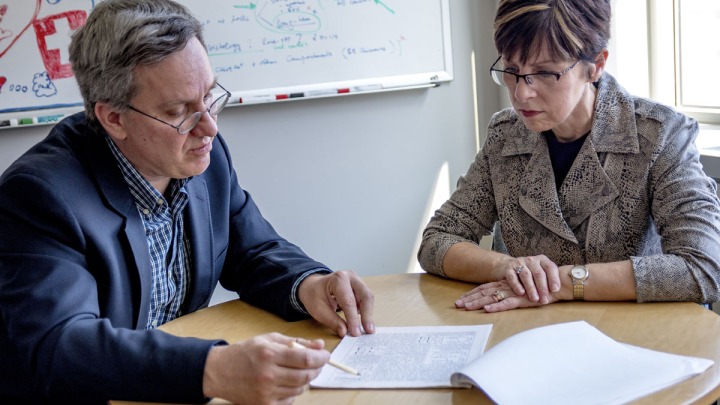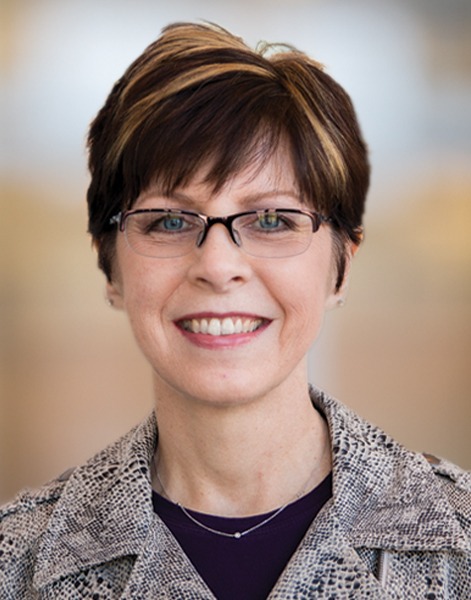
Personal Essay: A day in the life (of science)
By Alicia Buisst
“From now on we live in a world where man has walked on the Moon. It's not a miracle; we just decided to go." — Jim Lovell, astronaut, Apollo 13 (circa 1969)
Beneath the artwork depicting cells and synapses, molecules and mitochondria, our tour group gathered in the lobby of the Life Sciences Institute at the University of Michigan on a sunny afternoon. We were there because of our association with the Leukemia and Lymphoma Society of Michigan, visiting to learn about the research of one of the scientists the society supports.
Ivan Maillard, M.D., Ph.D., is a researcher and doctor specializing in leukemia and lymphoma. He gathered us into a circle.
“We are pursuing the study of basic science at LSI,” he began. “We are a collaborative group of researchers…”
Wait.
“How do you define ‘basic science?’” I asked.
“That’s a very good question,” Maillard answered with a smile. “It’s the pursuit of the scientific question. It’s scientific inquiry in its purest form. Inquiry for the sake of knowing how and why.”
Noble work, no doubt, but how does the pursuit of basic scientific inquiries translate into relevant experiments, new technologies and groundbreaking discoveries? Into new treatments for patients like those in our group visiting that day? Patients with cancer, sometimes rare and very serious blood cancer? Patients like me?
It was 10 years since my first diagnosis of Myelodysplastic Syndrome (MDS) and only 12 months since my first relapse into Acute Myeloid Leukemia (AML). Six months since my second. Relapse was a doorway I never thought I’d enter, let alone twice.
I was skeptical that “basic science” — the term seemed like something I studied in junior high — could really matter to a cancer patient. Maillard led the tour group out of the lobby and opened the door to his lab, and it was a door I eagerly walked through, wanting to know how the work being done at LSI could help me.
At the launch pad
Maillard and his lab team are researching how the human body creates and maintains blood stem cells and an immune system when operating in health — and when under stress. In leukemia patients who undergo bone marrow transplants, the body has to start from ground zero to rebuild an immune system. Maillard’s research aligns with Cancer Moonshot 2020 — former Vice President Joe Biden’s initiative to accelerate 10 years of cancer research into five years, and to find cures for cancers by the end of the decade.
In the LSI labs, standard-issue test tubes, microscopes and equipment were laid out in aisles, with students in goggles and gloves at the helms of various experiments. We approached an open area with long tables, bright natural light and a heart-shaped array of electrical outlets. Here investigators converge and discuss who is doing what, what happened and how to think about what they did here, so that others can do something different over there.
One of the grad students came forward and explained how he was using a synchrotron — a type of particle accelerator — to bounce electrons off of crystalized proteins.
But wait!
I thought cancer research was all liquids and solutions and beakers of fluids and infusion bags. And weren’t particle accelerators used for non-cancerous, non-test-tube-holding, abstract physics experiments to understand the movements of atomic particles that I could barely imagine, let alone connect to my own disease?
It turns out that these researchers were working to understand the function of these proteins (for instance, those involved in helping cancer to spread) and how chemical compounds — potential drugs — might interact with them.
Inner-space
We headed into a large elevator going to the basement and walked down a long hallway that led to a semi-circular space with three tall doors.
As I stood listening to the description of what was behind door numbers one, two and three, I felt I was about to enter a high-tech Pandora’s box, with the potential to unveil concepts we’d never imagined before.
LSI is home to some of the most powerful, state-of-the-art electron microscopes available. These microscopes visualize proteins at high-resolution, such that scientists can see the structure and atomic detail of proteins in 3-D. These proteins are 10,000 times smaller than the width of a human hair! The protein molecules are frozen instantaneously at super low temperatures (‘cryo’ temperatures, at around -180 degrees Celcius), capturing different states of the molecules in a thin layer of ice. The microscopes are then used to take many thousands of snapshots of these frozen molecules that are then pieced together to reveal a 3-D map of the intact protein.
These ‘cryo-microscopes’ are like an inverted Hubble space telescope: Instead of looking out deep into the history of the universe, they look inward to the beginnings of existence itself.
Building a better rocket ship

We reconvened in a conference room, and some of Maillard’s research team joined our tour group, introducing themselves and speaking about what they are working on and why they chose to be a part of LSI.
LSI researchers are the engines of inquiry, every day searching for — and occasionally finding — the building blocks needed for a better world. While many research groups at universities and hospitals around the world are working around the same theme, here teams from different disciplines purposefully cross-pollinate in a planetary partnership to seek the knowledge that could lead to new treatments for cancers, among many other diseases and illnesses.
These individuals are curious about the how, and the why and the what-if and the what-then — and that’s how humanity has made the giant leap from stone wheels to wheels-up when an airplane takes flight. Curiosity. Plain, pure and powerful. Basic.
I got it. I now understand that the work being done at LSI is impacting my world, my health, my future and that of countless others with leukemia, lymphoma and the many other –emias and –omas that bring havoc and pain. Basic scientific inquiry lays the groundwork to trouble-shoot problems that are part of the human condition. Like cancer. Basic science led to the life-saving biotechnology that led to the successful transplantation of stem cells from bone marrow into another human being. Like me.
Basic science helped to save my life.
Listening to these LSI researchers reminded me about a PBS documentary on Nikola Tesla, who developed alternating current. Imagine a circuit of millions of bits of electrons, constantly moving back and forth, overlapping, up and down, over and above each other, generating a steady stream of power.
LSI investigators are like alternating current: thoughts and ideas continually flowing in a collaborative jet-stream, drawing energy and momentum from all around them, powering scientific inquiry.
Like molecular bonds connect two atoms of hydrogen to one atom of oxygen, the dots connected and it was as clear to me as water. LSI conducts basic scientific inquiry on extraordinary levels, rooted in the simplicity of human curiosity. Basic science put a human being on the moon. If it can do that, it can find a cure for cancer. It’s that simple.
Alicia Buisst is a freelance writer and speaker. She is writing a book about her journey through blood cancer.


